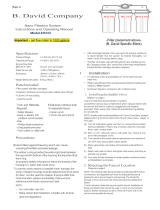
Filter Cartridge Replacement
• Filter cartridges the US-1000 will last about 500 gallons or six
months before they need to be replaced. Filter cartridge life
varies depending on usage, and/or water conditions. Changes in
taste, color, and flow of the water being filtered indicate that the
cartridge should be replaced.
• Read all instructions before replacing filter cartridges.
1. Turn off cold water supply and open the drinking water faucet to
release pressure from system.
2. Unscrew and remove bottom of filter housing. Locate and remove
large O-ring, wipe clean of lubricant, and set aside. Repeat for
second housing.
3. Discard used filter cartridges. Using a non-abrasive sponge or
cloth, scrub the bottom of filter housings, O-ring grooves, and caps
with dish soap and warm water. Rinse thoroughly. Fill bottom of
each housing 1/3 full with water. Add 1 tablespoon of household
bleach and scrub to disinfect.
4. Lubricate O-rings with silicone grease. Insert each O-ring in groove
and press into place.
NOTE: This step is important to ensure a proper housing seal.
Make certain each O-ring is seated level in its groove or a leak may
occur.
5. Screw bottom of housings with bleach water onto caps without
filter cartridges and hand-tighten. DO NOT OVERTIGHTEN.
6. Turn on water supply. Let faucet run for about 10 seconds, then turn
off faucet and let stand for 20-30 minutes.
7. Turn on faucet and allow bleach water to run out (about 3-5
minutes).
8. Turn off water supply to system and open faucet to release
pressure. Remove bottom of housings and empty of water.
9. Insert each filter cartridge in bottom of appropriate filter housing:
W-250 Cartridge Set: white with green end caps in left housing,
gray plastic cartridge in right housing
NOTE: The filter cartridges should be installed with the black
gasketed ends pointing up.
10. Screw bottom of housings onto caps and hand-tighten. DO NOT
OVERTIGHTEN. Make certain cap standpipe slips into cartridge.
11. Open water supply and turn on drinking water faucet to release
pressure in system. Let faucet run for 5 minutes to remove trapped
air and carbon fines. Check system for leaks before leaving
installation.
NOTE:
• It is recommended that you run the tap at least 20 seconds prior to
using water for drinking or cooking purposes.
• Initially, filtered water may appear cloudy. If you set a glass
of water on a level surface, you should be able to watch the
cloudiness disappear from the bottom of the glass upwards.
This harmless cloudiness results from the release of trapped air
within the cartridge and will disappear within a few weeks after
installation.
Troubleshooting
Leaks:
...between cap and bottom of filter housing
Turn off water supply valve and turn on drinking water faucet to
release pressure in system. Remove bottom of housing. Clean O-ring
and O-ring groove (located directly beneath threads of housing).
Lubricate O-ring with silicone grease and replace securely into
groove. Screw bottom of housing onto cap and hand-tighten. DO NOT
OVER-TIGHTEN. Turn on water supply valve and check for leaks.
...on system inlet/outlet connections
Turn off water supply valve and turn on drinking water faucet to
release pressure in system. Remove tubing from fitting (see NOTE
under Step Six: Connecting the Supply Adapter on p.3) and make sure
end of tubing is cut squarely and free of scratches or burrs. Reinsert
tubing into quick-connect fittings, making sure to push securely until
tubing hits a hard stop. Turn on water supply valve and check for
leaks.
...on supply adapter connection
Turn off water supply valve and turn on drinking water faucet to
release pressure in system. Loosen leaking threaded fitting on supply
adapter or pull out leaking tubing from fitting. Inspect to see if plastic
tubing is scratched or supply adapter was properly attached. If tubing
is scratched, cut off 1/2" to 5/8" and reinstall per Step Six: Connecting
the Supply Adapter. Reconnect tubing or tighten compression nut with
fingers, then tighten nut snugly 1/2-turn with wrench. Turn on water
supply valve and check for leaks.
...on faucet/tubing connection
Turn off water supply valve and turn on drinking water faucet to
release pressure in system. Loosen and remove compression nut
fitting on faucet stem. Make sure tubing is inserted firmly into end of
faucet stem, then retighten compression nut with fingers until secure
then tighten 1 turn with a wrench. Turn on water supply valve, then
turn off faucet to check for leaks.
NOTE: If leaks persist, or if there are other leaks on system, turn off
water supply. Call our technical support department at 800.861.8758.
Low Water Flow
1. Check flow at faucet. The US-1000 system should fill a gallon jug
in approximately 2 minutes. Flow rates will vary with individual
household water pressure.
2. Check filter cartridge installation. Make certain both filter
cartridges are properly oriented in filter housings (See Filter
Cartridge Replacement).
3. Check to be certain that the water supply valve is completely open
(turn handle on valve counter-clockwise as far as it will go).
4. Check flow through empty system. To do this, turn off water supply
valve and turn on drinking water faucet to release pressure in
system. Then remove filter cartridges from housings and screw
housings back onto caps. Turn on faucet to check flow through
empty system. Flow should be about one to two gallons per
minute. If flow is less than 0.4 gallons per minute, call Technical
Support at 800.861.8758.
5. If flow through empty system is adequate, place one filter
cartridge in system at a time and check flow to make sure
cartridge is not clogged. Replace clogged cartridge if necessary.
5









